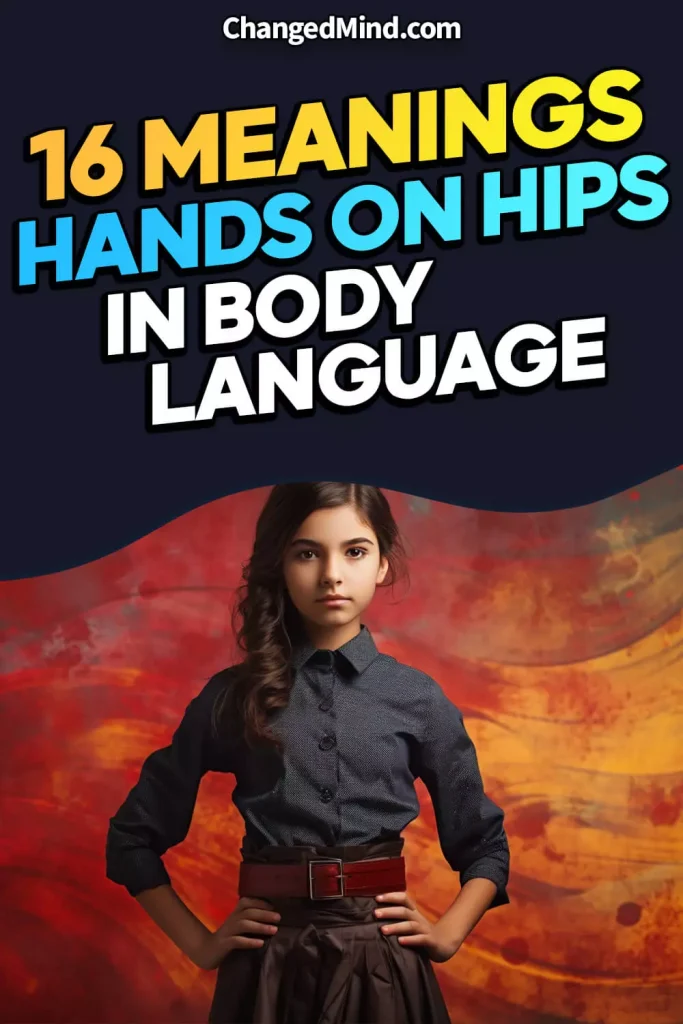Ever been caught wondering what’s really going on when someone puts their hands on their hips? Well, get ready to unveil the secret language of ‘Hands on Hips in Body Language’!
Why Keep Reading: In this article, we’re spilling the beans on 16 intriguing interpretations behind this seemingly simple gesture. From the sassy to the assertive, we’ll explore:
- The ‘I Mean Business’ Pose
- The ‘I’m Fed Up’ Stance
- The ‘Confidence Booster’
- The ‘Read My Mind’ Move
- The ‘I’m in Control’ Gesture
- The ‘I Need My Space’ Sign
Join us on this enlightening journey to decipher what’s really on someone’s mind when their hands find their way to their hips. It’s time to decode ‘Meanings Of Hands on Hips in Body Language’!
Body language is a powerful form of non-verbal communication that can reveal a person’s thoughts, emotions, and intentions. One specific gesture that often catches attention is when someone stands with their hands on their hips.

This posture is known to convey various meanings depending on the context and the individual. Understanding the implications of this gesture can provide valuable insights into a person’s mindset and attitudes.
Reputable body language expert, Joe Navarro, describes this gesture as a power pose that conveys confidence and dominance. It is a way for individuals to assert themselves and exhibit a sense of control in a situation. It is important to consider the context and other cues to accurately interpret the meaning behind this gesture.
The hand on hips gesture can have both positive and negative connotations, depending on the accompanying body language and facial expressions.
In certain contexts, standing with hands on hips may indicate assertiveness and readiness for action. It can convey a person’s confidence in their abilities and their willingness to take charge.
On the other hand, this gesture can also be associated with impatience and frustration, especially when combined with signs of agitation or a stern facial expression. These subtle cues can help decipher the intended message behind this gesture.
It is worth noting that cultural differences play a significant role in interpreting body language, including the hand on hips gesture. In some cultures, this posture may be seen as a sign of disrespect or insubordination, while in others, it may be considered a normal and acceptable stance.
Therefore, it is essential to be mindful of cultural variations and avoid making assumptions based solely on this gesture. By considering the context, accompanying cues, and cultural norms, we can gain a better understanding of what it means when someone stands with their hands on their hips.
Key takeaway:
- Understanding non-verbal communication: Body language plays a significant role in conveying messages beyond words.
- Hand on hips as a gesture: Analyzing this gesture can reveal insights into someone’s confidence and dominance.
- Interpreting the hand on hips gesture: It can have positive connotations of assertiveness and control, but also negative connotations of impatience and frustration. Context matters to determine the exact meaning.
16 Meanings Of Hands on Hips in Body Language
Here are 16 meanings of “Hands on Hips” in body language:
- Confidence: Standing with hands on hips can convey self-assuredness and assertiveness.
- Authority: It’s a power pose, signifying control and authority.
- Impatience: Restless movements of hands on hips indicate impatience or frustration.
- Readiness: It can signify readiness to take action or face a challenge.
- Defiance: A defiant or rebellious attitude may be conveyed by this gesture.
- Evaluation: People often use this pose when assessing a situation.
- Assertiveness: It can communicate a firm stance or refusal to back down.
- Dominance: A way to establish dominance or mark territory.
- Annoyance: Hands on hips might indicate irritation or annoyance.
- Superiority: It can be used to show superiority or disdain.
- Openness: When paired with open body language, it can mean approachability.
- Resignation: It may indicate acceptance or resignation in some contexts.
- Exasperation: When accompanied by sighs or eye rolls, it often means exasperation.
- Evaluation: People use it to critically evaluate something or someone.
- Pondering: Hands on hips while looking thoughtful can indicate deep contemplation.
- Preparedness: A stance of readiness, indicating someone is prepared for action.
Understanding these meanings can help you decode the intentions or emotions of someone using this body language gesture.
What Hands on Hips Means in Body Language:

Discover the intriguing world of body language and its significance in understanding non-verbal communication. Uncover the hidden meanings behind someone standing with their hands on their hips.
From subtle cues to powerful gestures, this section unveils the captivating realm of non-verbal communication, shedding light on the unspoken messages conveyed through our bodies.
Get ready to decode facial expressions, gestures, and postures, as we delve into the fascinating realm of body language.
Understanding Non-Verbal Communication
Understanding Non-Verbal Communication is crucial for effective communication. Non-verbal cues convey more meaning than words alone. Here are key points to consider in understanding non-verbal communication:
1. Importance of Non-Verbal Communication: Non-verbal cues provide insights into a person’s emotions, attitudes, and intentions. Understanding these cues improves communication and builds stronger relationships.
2. Facial Expressions: Facial expressions convey emotions. A smile indicates happiness or friendliness, while a furrowed brow may convey anger or confusion. Pay attention to these expressions to interpret emotions accurately.
3. Body Posture and Gestures: How a person stands, sits, or moves provides information about their confidence, interest, or engagement in a conversation. Open and relaxed body posture indicates receptiveness, while crossed arms suggest defensiveness.
4. Eye Contact: Eye contact plays a significant role in non-verbal communication. Sustained eye contact shows interest and attentiveness, while avoiding eye contact may indicate discomfort or disinterest. Consider cultural differences in the meaning of eye contact.
5. Tone and Pitch of Voice: Vocal elements like tone, pitch, and volume convey emotions or emphasize certain words or phrases. Paying attention to vocal cues helps understand the underlying meaning of a person’s words.
6. Context and Congruence: Understanding non-verbal communication requires considering the overall context. Non-verbal cues should align with verbal messages to establish credibility and trust. Inconsistencies may indicate deception or hidden emotions.
7. Cultural Differences: Non-verbal communication varies across cultures. Gestures and expressions may have different meanings. Being aware of these variations prevents misunderstandings and promotes effective communication.
Understanding non-verbal communication is essential for interpreting true meaning. By paying attention to facial expressions, body language, eye contact, vocal cues, and cultural differences, we gain a deeper understanding of others and enhance communication skills.
Hand on Hips: A Gesture to Analyze

Analyzing the gesture of placing hands on hips reveals intriguing insights into our body language. Discover the power pose and how it impacts our confidence and dominance.
Uncover the hidden meanings behind this simple yet commanding stance. Let’s explore the fascinating world of hand on hips and unravel its significance in our social interactions.
The Power Pose
The Power Pose, also known as the power stance, is a body language posture that conveys confidence and dominance. It involves standing tall with hands on hips and elbows out to the sides. This pose is commonly associated with assertiveness and control.
The Power Pose can be a powerful tool for boosting self-confidence and enhancing perceived authority. In professional settings, it cultivates leadership and commands respect. By adopting this pose, individuals signal readiness for action and display determination.
It is important to note that the Power Pose can have negative connotations in certain contexts. For instance, if accompanied by a stern facial expression, it might be interpreted as impatience or frustration. In social situations, the Power Pose can come across as overly dominant or aggressive, depending on cultural norms.
Cultural differences play a significant role in interpreting the Power Pose. While standing with hands on hips may signify confidence and strength in some cultures, it could be viewed as disrespectful or confrontational in others. Therefore, it is crucial to be aware of cultural norms and adjust body language accordingly.
When used appropriately and in alignment with cultural expectations, the Power Pose can be an effective tool for projecting confidence and authority.
The hand on hips gesture: the universal sign of ‘I’m not just confident, I’m also the boss.’
Confidence and Dominance
Confidence and Dominance are key aspects of the hand on hips gesture. When someone stands with their hands on their hips, it indicates self-assurance and authority. Here are important points to consider when interpreting this gesture:
1. Posture: Confidently placing hands on hips signifies an open and expansive posture. This gesture helps occupy more space and project dominance.
2. Body Language: The hand on hips gesture is a power pose scientifically linked to increased confidence. It conveys dominance to others.
3. Assertiveness: Standing with hands on hips demonstrates assertiveness and a willingness to take charge. It signifies confidence in abilities and readiness to assert opinions, ideas, or decisions.
4. Leadership: This gesture is often associated with individuals in leadership positions. It conveys authority and control, indicating that the person is in charge and can handle any situation confidently.
5. Dominance: The hand on hips gesture also conveys a sense of dominance. It implies control and expects others to acknowledge authority.
It is essential to note that the interpretation of this gesture may vary depending on the context and cultural background. While confidence and dominance are commonly associated with the hand on hips gesture, it is crucial to consider other non-verbal cues and the overall situation to fully understand an individual’s intentions.
When encountering someone displaying the hand on hips gesture, it is advisable to observe other non-verbal cues and consider the overall situation to gain a comprehensive understanding of their attitudes and intentions.
Interpreting the hand on hips gesture is like trying to decipher an ancient language, but with less hieroglyphics and more sass.
Interpretation of Hand on Hips Gesture
When someone stands with their hands on their hips, it’s more than just a casual pose. In this section, we’ll unravel the meaning behind this gesture, exploring both its positive and negative connotations.
Get ready to dive into the intriguing world of body language as we uncover the hidden messages conveyed by this simple yet meaningful stance.
Positive Connotations
When someone stands with hands on hips, it can have positive connotations depending on the context. Here are some positive meanings associated with this gesture:
- Confidence: Standing with hands on hips displays confidence, self-assurance, and self-belief.
- Assertiveness: The hand-on-hips gesture conveys assertiveness and a willingness to take charge.
- Authority: This gesture indicates authority or leadership qualities, signaling that the person is in control and capable of making decisions.
- Openness: Standing with hands on hips suggests an open and approachable demeanor, making others feel comfortable and more willing to engage in conversation.
- Readiness for action: Having hands on hips shows a person is ready to take action or tackle tasks, indicating preparedness and eagerness to get things done.
- Positive energy: The hand-on-hips gesture exudes positive energy, making the person appear enthusiastic, motivated, and ready to face challenges.
- Optimism: Standing with hands on hips can denote a positive outlook on life and a hopeful and optimistic attitude towards the future.
- Approachability: This gesture makes an individual seem approachable and friendly, creating a welcoming atmosphere and inviting others to interact.
It is important to note that the interpretation of the hand-on-hips gesture can vary depending on cultural and individual differences. While these positive connotations are commonly associated with the gesture, it is essential to consider the context and the person’s overall body language to fully understand their intended message.
Is that hand on your hip a power pose or just a sign that you need a bathroom break?
Negative Connotations
Understanding the negative connotations associated with the hand on hips gesture can help interpret non-verbal cues accurately. It is important to consider the context and other accompanying body language signals to fully understand the intended meaning behind this gesture.
The hand on hips gesture, when combined with other negative body language cues like crossed arms, tense facial expressions, or clenched fists, intensifies the negative connotations. It creates a strong impression of hostility, anger, or frustration.
Using the hand on hips gesture with crossed arms or a stern facial expression indicates defiance or resistance. It suggests a refusal to comply with instructions or requests, which can be seen as displaying arrogance or superiority. This conveys self-importance and a disregard for others. In confrontational situations, such as during an argument or disagreement, using the hand on hips gesture can be aggressive and intimidating. It signals readiness to engage in a verbal or physical altercation.
When someone is frustrated or annoyed, they may unconsciously use the hand on hips gesture to release tension. This indicates dissatisfaction or irritation with a situation or person. The hand on hips gesture can also be a non-verbal way to express disapproval or displeasure, showing disagreement or signaling that something does not meet the person’s standards.
In certain situations, it can be interpreted as a sign of hostility, indicating a readiness to engage in aggressive behavior or serving as a warning to others to keep their distance.
When someone feels attacked or criticized, they may adopt the hand on hips gesture as a defensive posture. It can be a way to protect oneself and assert one’s position or viewpoint. By incorporating the hand on hips gesture with other negative body language cues, such as crossed arms, tense facial expressions, or clenched fists, the negative connotations are intensified. This creates a strong impression of hostility, anger, or frustration.
Context matters: Discover the hidden meanings behind the hand-on-hips gesture, from assertiveness and control to impatience and readiness for action.
Context Matters: Possible Meanings
When someone stands with their hands on their hips, it’s not just a casual posture. Context matters, and it can reveal fascinating insights about their mindset. In this section, we’ll explore the possible meanings behind this body language.
From assertiveness and control to impatience and frustration, and even readiness for action, each sub-section unveils a different aspect of this intriguing gesture. Get ready to uncover the hidden messages communicated through the position of hands on hips.
Assertiveness and Control
The hand on hips gesture is often associated with assertiveness and control. Standing with hands on hips signifies a confident and dominant posture, conveying power and authority in personal and professional settings.
By placing hands on hips, individuals display self-assurance and control over the situation. Leaders commonly use this gesture to establish dominance and assert authority. It is seen as a non-verbal way of expressing control and taking charge, indicating readiness to take action and make decisions.
This gesture can also be used to assert boundaries and show that one is not easily intimidated. Individuals who frequently use this gesture are often seen as confident and in control.
When interpreting the hand on hips gesture, consider the context and individual differences. While it generally represents assertiveness and control, it can also have negative connotations if used excessively or inappropriately.
Some may perceive this gesture as aggressive or confrontational, depending on the situation and cultural norms. It is important to consider the cultural context and individual personalities when interpreting the meaning of the hand on hips gesture.
Standing with hands on hips: the universal language of I’m in charge, so get out of my way before I lose my patience.
Impatience and Frustration
Impatience and frustration can be conveyed through the hand on hips gesture. This gesture involves placing one or both hands on the hips with the elbows pointing outwards.
It often accompanies a stern facial expression and indicates a heightened state of impatience or frustration.
1. Displaying impatience: When someone stands with their hands on their hips, it suggests impatience. This gesture signifies a desire for things to move faster or for someone to act more quickly. The person may tap their foot or sigh audibly, further indicating their impatience.
2. Expressing frustration: The hand on hips gesture can also express frustration, especially when combined with other non-verbal cues such as furrowed brows or tense facial muscles. It signifies displeasure or irritation with a situation or person, often due to a perceived lack of progress or understanding.
3. Body language cues: When someone adopts the hand on hips gesture out of impatience and frustration, their body language is likely to be tense and closed off. Their shoulders may be slightly raised, and their stance may be rigid. They may also show signs of restlessness, such as shifting their weight or fidgeting.
4. Caution in interpretation: While the hand on hips gesture commonly signifies impatience and frustration, it is important to consider the context. Cultural differences and individual variations can influence its meaning. Other non-verbal cues and verbal communication should be taken into account for a more accurate interpretation of the person’s emotions and intentions.
5. Fact: Studies have shown that impatience can lead to negative outcomes in various aspects of life. It can result in poor decision-making, impaired relationships, and increased stress levels. Developing patience and using stress-management techniques can improve overall well-being and enhance interpersonal interactions.
Readiness for Action
When someone stands with their hands on their hips, it indicates a strong readiness for action. Here are steps to consider when interpreting this body language:
- Forward stance: When someone has their hands on their hips, they adopt a forward stance, with their chest forward and weight shifted slightly forward. This signifies a great readiness to spring into action.
- Open and expansive posture: Standing with hands on hips creates an open and expansive posture. This indicates confidence and being in control, highlighting preparedness for action.
- Engaged body language: The individual may also display other signs of readiness for action, such as leaning forward slightly, making direct eye contact, and having a focused expression. These behaviors demonstrate attentiveness and alertness to take action.
- Readiness to take charge: The hands-on-hips gesture conveys a willingness to take charge and lead. It signals that the person is fully ready to initiate action or make timely decisions.
- Energy and drive: This body language suggests a high level of energy and drive. It reflects motivation and determination to tackle challenges head-on and be fully prepared for action.
To further understand the significance of readiness for action, let’s explore a true historical example. During World War II, Winston Churchill, the Prime Minister of the United Kingdom, often stood with his hands on his hips during his famous speeches and public appearances.
This body language showcased his strong readiness to lead his country during a time of crisis and conveyed his determination to take decisive action against the enemy.
Churchill’s confident and commanding posture inspired and reassured the British people, boosting their morale and reinforcing their own readiness for action.
Cultural Differences
Different societies have distinct norms, values, and practices that shape their behavior and interactions. These cultural differences can be observed in communication styles, social customs, and body language.
One significant aspect of cultural differences is personal space. In Western countries, individuals highly value a larger personal space, while in many Eastern cultures, people are more accustomed to being in close proximity to others.
Another example of cultural differences is seen in greetings. In Western cultures, a handshake is a common greeting, but in Japan, bowing is the traditional way to greet someone.
Cultural differences also extend to the concept of time. Some cultures highly value punctuality, while others have a more relaxed approach to time.
Taboos around food are another facet of cultural differences. Certain cultures have dietary restrictions based on religious or cultural beliefs.
Even nonverbal communication cues can vary across cultures. For instance, standing with hands on hips can have different meanings in different cultures.
Understanding and respecting cultural differences is crucial for effective communication and building relationships in multicultural environments.
Throughout history, cultures have developed independently, resulting in diverse traditions, customs, and ways of life.
The exploration and colonization of new territories have contributed to the blending of cultures.
Trade routes, such as the Silk Road and the Trans-Saharan trade route, played a significant role in connecting civilizations and facilitating the exchange of goods, ideas, and cultural practices.
Colonization of territories by European powers brought about cultural interactions and a combination of indigenous and colonial influences.
In the modern era, globalization, technological advancements, and increased mobility have further intensified cultural interactions.
Recognizing and appreciating cultural differences is essential for fostering understanding, respect, and harmony among diverse communities.
Some Facts About What It Means When Someone Stands With Their Hands on Their Hips:
- ✅ Standing with hands on hips is a common body language pose that typically indicates assertiveness and readiness for action. (Source: changedmind.com)
- ✅ The hands on hips gesture can also be a sign of anger, irritation, or a desire to appear bigger and intimidate others. (Source: changedmind.com)
- ✅ When someone rests their hands on their hips during a conversation, it can mean they are bored or mentally placing themselves in the speaker’s shoes. (Source: changedmind.com)
- ✅ The hands on hips pose is often associated with being ready for action, like a boxer or athlete waiting for a round or game to start. (Source: changedmind.com)
- ✅ This body language gesture is commonly observed in women and may indicate annoyance and a readiness to take action. (Source: changedmind.com)
Frequently Asked Questions
What does it mean when someone stands with their hands on their hips?
When someone stands with their hands on their hips, it is a common body language pose that typically indicates assertiveness, readiness for action, and various emotions depending on the context and accompanying body language cues.
What emotions can be conveyed by the hands on hips pose?
The hands on hips pose can convey assertiveness, irritation, anger, boredom, annoyance, curiosity, and a desire to appear bigger and intimidate others. It is important to consider other body language cues to accurately interpret the specific emotions being expressed.
Does the hands on hips pose have different meanings in different situations?
Yes, the meaning of the hands on hips pose can vary depending on the situation. For example, it can indicate assertiveness in a professional setting like a police officer on duty, or it can be a relaxing position for tired sports players. The context and accompanying body language cues play a crucial role in understanding the intended message.
What does it mean if someone clenches their hands while assuming the hands on hips pose?
If someone clenches their hands while assuming the hands on hips pose, it signals hostility in addition to assertiveness. It may be difficult to calm this person down, but giving them something to hold can help break their hostile attitude.
Are there variations of the hands on hips pose that convey different emotions?
Yes, there are variations of the hands on hips pose that can convey different emotions. For example, resting the back of the hands on the hips with palms facing outward indicates annoyance, and putting the thumbs back with flat hands vertically indicates assertiveness and curiosity.
Can body language experts make reliable judgments based on the hands on hips pose?
Body language experts can make reliable judgments based on the hands on hips pose when considering the context and other accompanying body language cues. It is important to remember that individual differences and cultural norms can influence the interpretation of body language gestures.






